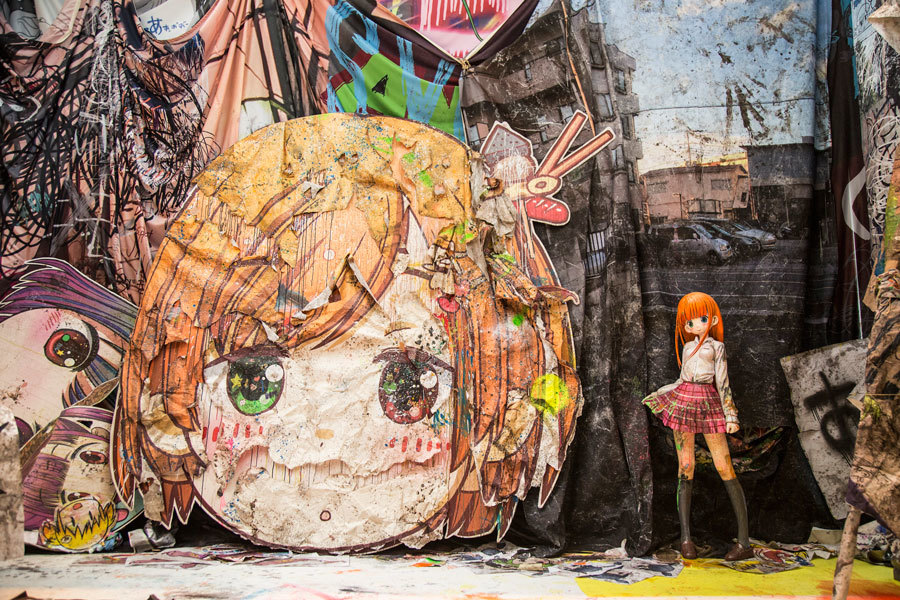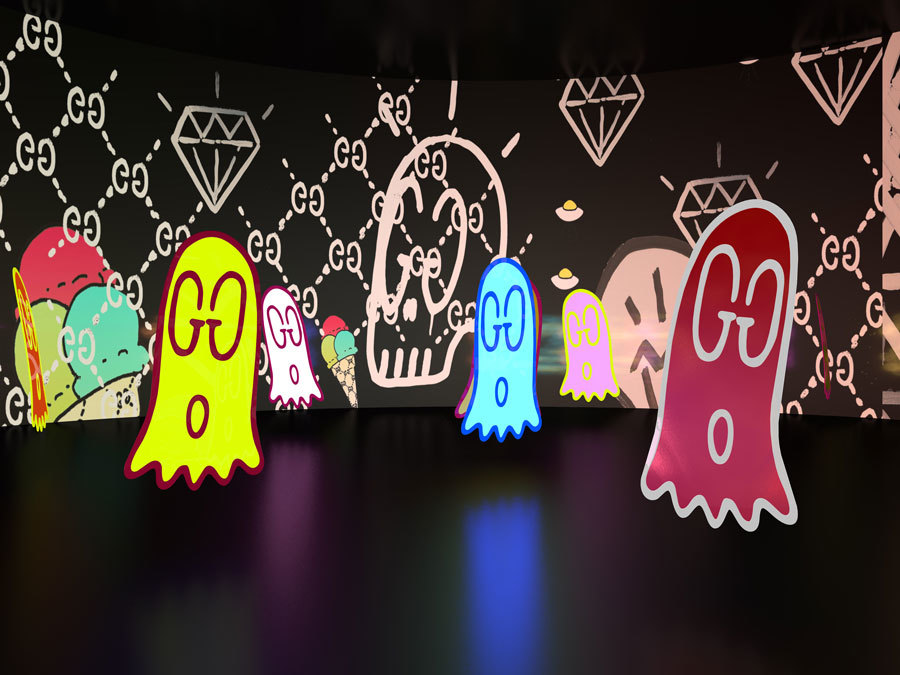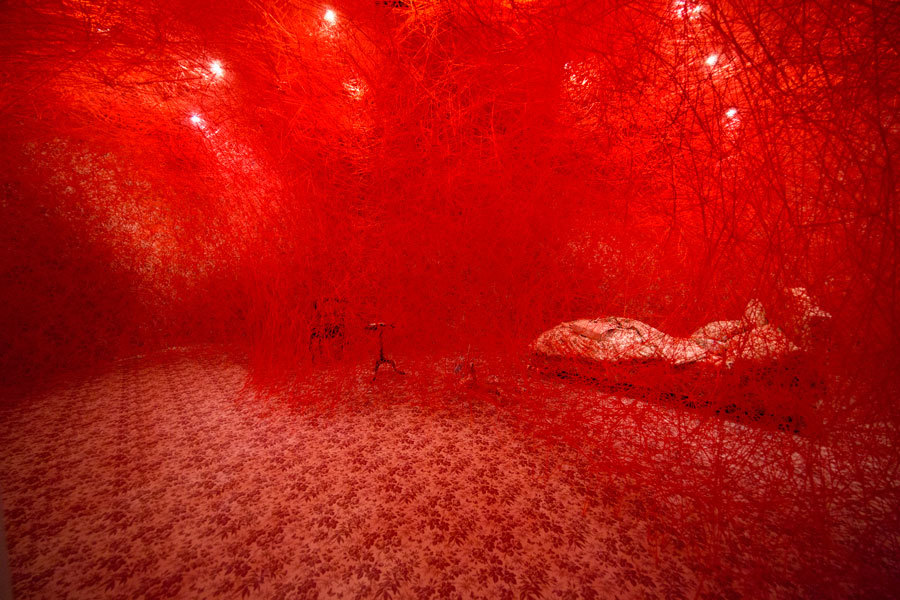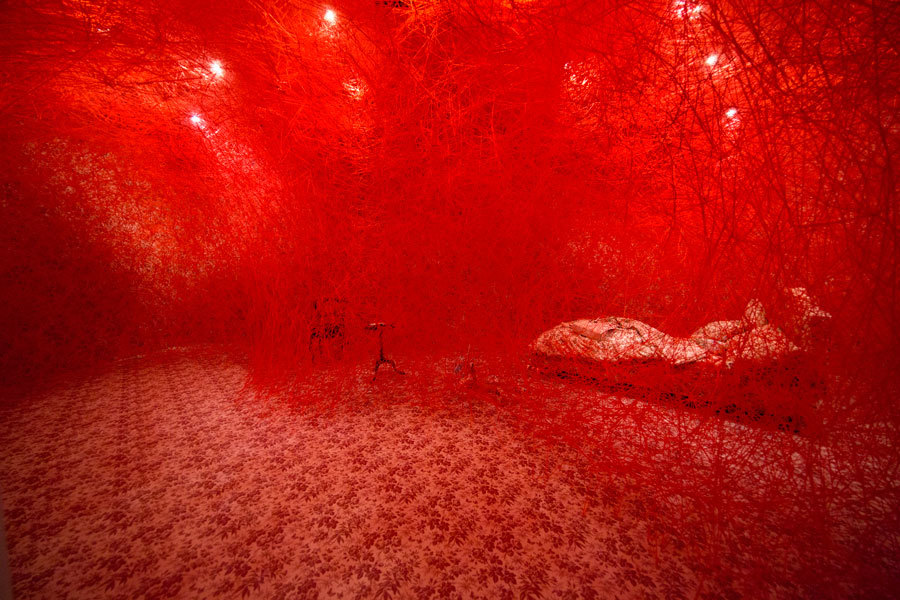There is something indefinable about Alessandro Michele’s interpretation of Gucci; references clash and compete with one another, aesthetics disrupt as much as they create a strong sense of harmony. His world is like a great baroque disorder, behind its obvious chaos, order prevails. The Gucci tornado draws inspiration from the outside world but remains self-sufficient. For the (digital and physical) exhibition Gucci 4 Rooms that opened in Tokyo yesterday, the fashion house gave carte blanche to four artists and asked each of them to create a “room” inspired by the universe of the brand.
In accordance with Michele’s creative approach, the four artists didn’t have much in common — but the designer let them express and develop their own vision of the house. The Japanese artist Chiharu Shiota, whose work was recently exhibited at the Japan Pavilion at the Venice Biennale, reinterpreted the Herbarium motif, weaving it into the air with hundreds of threads to create a surreal, dreamlike space. The iconic street artist Mr. imagined a very kitsch yet apocalyptic installation inspired by Japanese manga characters and made out of waste. The new face of digital art, Japanese artist Daito Manabe, created an interactive installation thought as an homage to Gucci’s mythology. The Canadian street artist Trouble Andrew, who has been collaborating with Gucci for two seasons already, covered a whole room with his famous Gucci Ghost creatures. The beautiful chaos of the exhibition reflects Gucci’s world: a little cosmos sealed away from the tyranny of trends, open to creativity and youth.

MR.
Can you tell me more about the project and how you devised the idea for this room?
I was interested in the hybrid. This is the keyword. It’s a mixture of trash and Japanese anime characters.
Was it easy to integrate Gucci into this series?
Gucci’s world and my world are completely different. We both have our universes. We’re not similar, but complementary.
Gucci under Alessandro Michele is more about pop culture than it used to be. Do you feel that? Or do you still consider Gucci as a very luxury brand?
Alessandro Michele is very interested in Japanese culture, in the yankii culture — the bad boy, the bad girl, the high-school gangs. I saw the video of his fall/winter collection and I saw many Japanese references, like the Pachinko, the decoration truck, the motorbike… In his Gucci aesthetics, there is something Japanese in the understanding of kitsch.
Is your own universe inspired by this yankii culture?
The 80s were a very popular age of the yankii culture and imagery. At that time I was 15 years old. I was very influenced by these characters. I also enjoyed riding modified motorbikes.
Do you think younger generations today are still influenced by this 80s yankii culture?
I believe it’s more of a heritage now. The people of the yankii culture have a bad reputation — they are often considered as bad people, doing bad things, often breaking the law, even if they don’t! So maybe younger generation take the good points from it, and tend more and more to erase the bad of it.
What do you think of the young generation of street artists in Japan?
I believe there’s two types of street culture today in Japan. One that’s putting fashion in the street, and another one putting street in fashion.

TROUBLE ANDREW
How do you feel about this exhibition? You, Gucci, and Japan are an association that feels very organic.
Great! This collaboration, started a few months ago now. With Alessandro and Gucci, it has always felt very simple and organic. He is cool and instinctive. We don’t think things through too much, we just do things.
How would you describe Alessandro Michele’s world?
It’s very open and welcoming. But just from the time we spent together I could definitely see — just by the way that everybody is working around, and everybody is feeling around him — he makes everybody feel so welcome. He takes risks, and that says a lot about him as a person. It was a big risk for him to bring me on! But he never stressed about that.
How do you see the future of this collaboration?
We’ve never put any time limit or any kind of rules or planning around this whole thing. It has honestly come out of just us spending time with each other, having fun, and exchanging ideas. It keeps growing, but it started off with us not knowing if it was going to be a print or whatever. Then it went into the first collection, the jewelry, and now all of these events, which came out of just us dreaming. I can’t really tell you what’s next, but we’re naturally taking it day by day, and it has been going well so far.
Is it a luxury to be able to work like that, so organically?
Yes, for sure. But it’s also an art. That’s the way that I want to live my life. That’s what I have to do — I can’t do it any other way. I just have to really love what I do or I’ll just stop doing it.
What do you think about art collaborating with fashion?
I think it’s the most natural marriage. You can’t have one without the other. It’s like that with music, too. Everybody shares their inspiration and I think it’s a natural relationship.
Do you have any personal projects planned?
Like I said… I don’t make too many plans! Right now, I know I want a massage!

DAITO MANABE
What did you think of Gucci before collaborating with the house?
I always wondered how I would look dressed in various pieces of clothing, from different brands. For Gucci, I was thinking I’d rather wear it for a party, but that was before I worked with them. Now I think about Gucci differently. Wearing Gucci and collaborating with Gucci are two very different things. I have had to truly understand the philosophy of the brand to be able to reinterpret it.
How would you define their philosophy?
The products featured in my installation were inspired by mythology. Gucci is transforming this mythology into something contemporary. In my own work, I’m always mixing ancient things with technology and make my art out of that. In that sense, I thought Gucci and I had something in common.
You’re a multidisciplinary artist, working with video, sound, motion design. I guess it was easy for you to collaborate with a fashion brand?
For me, collaborating with various people from various backgrounds is a nice way to to express myself, to express my art. But I know some artists are very conservative, and they think art should be “pure.” They’re entitled to think that. But that’s not how I see things. I need to be able to work with people from other disciplines.
If you had to define Gucci in a few words?
Dynamic change. I feel that Gucci has no fear of change.

CHIHARU SHIOTA
How did you came up with that idea for the room?
When Gucci told me they wanted to create four hotel rooms, I went and created a room with a bed and chair, so people could feel like someone is already in the room.
I know you work with thread a lot — was it intuitive for you to work with it again? Why did you want it to be bright orange?
It looks orange, but it’s red. I think it helped me to create a cosmos, filled with the famous Gucci Herbarium motif and the lines that I always use with my threads.
Have you ever worked with a fashion brand before? How did this collaboration feel?
It’s my first collaboration with a fashion brand. I think the materials used in garments can be used for art, as clothes can be considered as a second skin. It can be as expressive as art. So using clothes for my artwork felt very natural to me.
How do you feel about artists who defend the idea that art has nothing to do with pop culture and fashion?
When Gucci offered me the chance to participate in the project they basically said I could be true to who I am, that I didn’t need to be close to their products. They gave me huge freedom.
How did you see the brand before, and how would you describe it now?
The products are very high-end, and may not be affordable for me, but I think some people buy these luxury brands because they want to fill the emptiness that they have inside themselves, which is quite similar to what I do when I create. My art fills the emptiness inside of me.
How do you think the art world is evolving?
We live in a world of exchanges. And because communication is easier today with the internet and social media, boundaries are thinner than before.
Credits
Text Tess Lochanski
